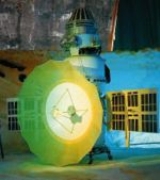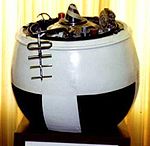
Venera 8
Encyclopedia
Venera 8 (manufacturer's designation: 3V (V-72)) was a probe
in the Soviet
Venera program for the exploration of Venus
.
Venera 8 was a Venus atmospheric probe and lander. Its instrumentation included temperature, pressure, and light sensors as well as an altimeter
, gamma ray spectrometer
, gas analyzer, and radio transmitters. The spacecraft took 117 days to reach Venus with one mid-course correction on 6 April 1972, separating from the bus (which contained a cosmic ray
detector, solar wind
detector, and ultraviolet spectrometer) and entering the atmosphere on 22 July 1972 at 08:37 UT. A refrigeration system attached to the bus was used to pre-chill the descent capsule's interior prior to atmospheric entry in order to prolong its life on the surface. Descent speed was reduced from 41,696 km/h to about 900 km/h by aerobraking
. The 2.5 meter diameter parachute opened at an altitude of 60 km.
 Venera 8 transmitted data during the descent. A sharp decrease in illumination was noted at 35 to 30 km altitude and wind speeds of less than 1 km/s were measured below 10 km. Venera 8 landed at 09:32 UT in what is now called Vasilisa Region, within 150 km radius of , in sunlight, about 500 km from the morning terminator
Venera 8 transmitted data during the descent. A sharp decrease in illumination was noted at 35 to 30 km altitude and wind speeds of less than 1 km/s were measured below 10 km. Venera 8 landed at 09:32 UT in what is now called Vasilisa Region, within 150 km radius of , in sunlight, about 500 km from the morning terminator
. The lander mass was 495 kg. It continued to send back data for 50 minutes, 11 seconds after landing before failing due to the harsh surface conditions. The probe confirmed the earlier data on the high Venus surface temperature and pressure (470 degrees Celsius, 90 atmospheres) returned by Venera 7
, and also measured the light level as being suitable for surface photography, finding it to be similar to the amount of light on Earth on an overcast day with roughly 1 km visibility.
Venera 8's photometer
measurements showed for the first time that the Venusian clouds end at a high altitude, and the atmosphere was relatively clear from there down to the surface. The on-board gamma ray spectrometer measured the uranium
/thorium
/potassium
ratio of the surface rock, indicating it was similar to granite
.
Space probe
A robotic spacecraft is a spacecraft with no humans on board, that is usually under telerobotic control. A robotic spacecraft designed to make scientific research measurements is often called a space probe. Many space missions are more suited to telerobotic rather than crewed operation, due to...
in the Soviet
Soviet space program
The Soviet space program is the rocketry and space exploration programs conducted by the former Union of Soviet Socialist Republics from the 1930s until its dissolution in 1991...
Venera program for the exploration of Venus
Venus
Venus is the second planet from the Sun, orbiting it every 224.7 Earth days. The planet is named after Venus, the Roman goddess of love and beauty. After the Moon, it is the brightest natural object in the night sky, reaching an apparent magnitude of −4.6, bright enough to cast shadows...
.
Venera 8 was a Venus atmospheric probe and lander. Its instrumentation included temperature, pressure, and light sensors as well as an altimeter
Altimeter
An altimeter is an instrument used to measure the altitude of an object above a fixed level. The measurement of altitude is called altimetry, which is related to the term bathymetry, the measurement of depth underwater.-Pressure altimeter:...
, gamma ray spectrometer
Gamma ray spectrometer
A Gamma-Ray Spectrometer, or , is an instrument for measuring the distribution of the intensity of gamma radiation versus the energy of each photon....
, gas analyzer, and radio transmitters. The spacecraft took 117 days to reach Venus with one mid-course correction on 6 April 1972, separating from the bus (which contained a cosmic ray
Cosmic ray
Cosmic rays are energetic charged subatomic particles, originating from outer space. They may produce secondary particles that penetrate the Earth's atmosphere and surface. The term ray is historical as cosmic rays were thought to be electromagnetic radiation...
detector, solar wind
Solar wind
The solar wind is a stream of charged particles ejected from the upper atmosphere of the Sun. It mostly consists of electrons and protons with energies usually between 1.5 and 10 keV. The stream of particles varies in temperature and speed over time...
detector, and ultraviolet spectrometer) and entering the atmosphere on 22 July 1972 at 08:37 UT. A refrigeration system attached to the bus was used to pre-chill the descent capsule's interior prior to atmospheric entry in order to prolong its life on the surface. Descent speed was reduced from 41,696 km/h to about 900 km/h by aerobraking
Aerobraking
Aerobraking is a spaceflight maneuver that reduces the high point of an elliptical orbit by flying the vehicle through the atmosphere at the low point of the orbit . The resulting drag slows the spacecraft...
. The 2.5 meter diameter parachute opened at an altitude of 60 km.

Terminator (solar)
A terminator, twilight zone or "grey line" is a moving line that separates the illuminated day side and the dark night side of a planetary body...
. The lander mass was 495 kg. It continued to send back data for 50 minutes, 11 seconds after landing before failing due to the harsh surface conditions. The probe confirmed the earlier data on the high Venus surface temperature and pressure (470 degrees Celsius, 90 atmospheres) returned by Venera 7
Venera 7
The Venera 7 was a Soviet spacecraft, part of the Venera series of probes to Venus. When it landed on the Venusian surface, it became the first man-made spacecraft to successfully land on another planet and to transmit data from there back to Earth.*Launch date/time: 1970 August 17 at 05:38...
, and also measured the light level as being suitable for surface photography, finding it to be similar to the amount of light on Earth on an overcast day with roughly 1 km visibility.
Venera 8's photometer
Photometer
In its widest sense, a photometer is an instrument for measuring light intensity or optical properties of solutions or surfaces. Photometers are used to measure:*Illuminance*Irradiance*Light absorption*Scattering of light*Reflection of light*Fluorescence...
measurements showed for the first time that the Venusian clouds end at a high altitude, and the atmosphere was relatively clear from there down to the surface. The on-board gamma ray spectrometer measured the uranium
Uranium
Uranium is a silvery-white metallic chemical element in the actinide series of the periodic table, with atomic number 92. It is assigned the chemical symbol U. A uranium atom has 92 protons and 92 electrons, of which 6 are valence electrons...
/thorium
Thorium
Thorium is a natural radioactive chemical element with the symbol Th and atomic number 90. It was discovered in 1828 and named after Thor, the Norse god of thunder....
/potassium
Potassium
Potassium is the chemical element with the symbol K and atomic number 19. Elemental potassium is a soft silvery-white alkali metal that oxidizes rapidly in air and is very reactive with water, generating sufficient heat to ignite the hydrogen emitted in the reaction.Potassium and sodium are...
ratio of the surface rock, indicating it was similar to granite
Granite
Granite is a common and widely occurring type of intrusive, felsic, igneous rock. Granite usually has a medium- to coarse-grained texture. Occasionally some individual crystals are larger than the groundmass, in which case the texture is known as porphyritic. A granitic rock with a porphyritic...
.
Payload experiments
- Temperature and pressure sensors - ITD
- Accelerometer - DOU-1M
- Photometers - IOV-72
- Ammonia analyser - IAV-72
- Gamma ray spectrometer - GS-4
- Radar altimeter
- Radio Doppler experiment

